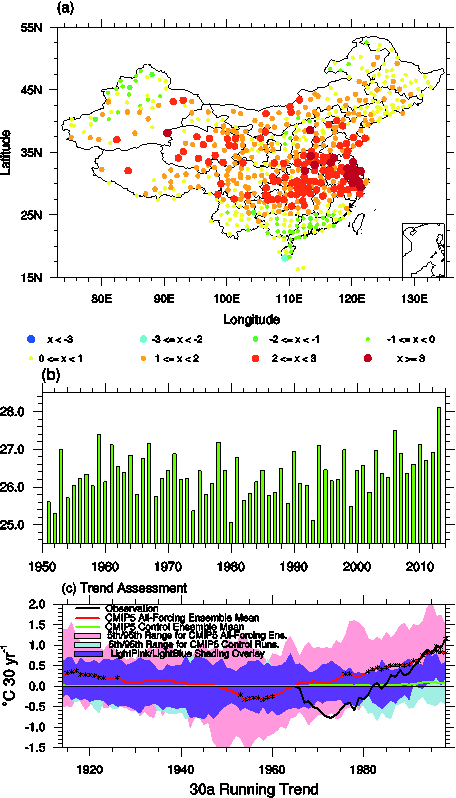Did anthropogenic forcing contribute to the hot summer in central eastern China during 2013?
Date:2014-10-20
Extreme weather and climate events have been the hottest topics in recent climate change studies due to their catastrophic nature. A combination of observed analysis, theoretical understanding, and numerical modeling demonstrates that global warming is increasing the risk of extreme events. July-August 2013 was the warmest such period in central eastern China since 1951 (Fig. 1a, b). Great public interest necessitates understanding the reason behind the hot summer and detecting the potential effect of anthropogenic forcing.
ZHOU Tianjun and his research team from the Institute of Atmospheric Physics (IAP), placed seasonal extreme warmth in central eastern China in 2013 in the context of long-term climate change, comparing the observed trends of the area-averaged July-August mean surface air temperature in central eastern China with simulations of 31Coupled Model Intercomparison Project Phase 5 (CMIP5) models that include both internal variability and responses to anthropogenic and natural forcing (Fig.1c). They found anthropogenic forcing had a discernible impact on the hot summer in central eastern China during 2013, with internal variability also being important.

Fig. 1 (a) July-August mean surface air temperature (tas) anomalies (℃) for 2013 (1961-1990 base period). (b) Time series of July-August mean tas averaged over the region (~24°N-33°N, 102.5°E-122.5°E) in Figure 1a of record warmth during July-August 2013. (c) The 30-year sliding trends (℃30 yr-1) in July-August mean tas averaged over central eastern China. The trend that is statistically significant at 1% level is represented as “*".
The finding is recently published in Bulletin of the American Meteorological Society.
Reference:
Zhou, T.*, S. Ma, L. Zou, 2014: Understanding a hot summer in central eastern China: Summer 2013 in context of multi-model trend analysis. [in "Explaining Extreme Events of 2013 from a Climate Perspective"]. Bulletin of the American Meteorological Society, 95(9), S54-S57.
